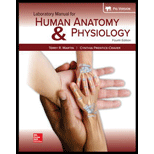
Concept explainers
The basis for communication in anatomy and physiology assumes
- the person is lying down.
Introduction:
Anatomy is related to body structure and function. It includes the study of cells, tissue, bones skeletal system, and organ system. It is distinct from physiology. It is the study of the function of the whole body and parts of the body. It focuses on the mechanisms and metabolic processes that occur in different organs of the body.
Answer to Problem 1PL
Correct answer:
The correct answer is option (c) Anatomical position.
Explanation of Solution
Explanation/justification for the correct answer:
Option (c). Anatomical position. In the anatomical position, the muscles are in minimum tension. It is erect or standing up position in humans. It is used as an initial point for physiological and anatomical descriptions and communications of the body. So, the correct answer is option (c).
Explanation for incorrect answer:
Option (a). The person is lying down. The lying position of a person is termed as supine and prone in which their body is supported by the surface underneath. It does not support the basis for communication, whereas it simply means the muscles of the body is in resting position. So, this is an incorrect option.
Option (b). Relative positions. The position defined concerning another position. Anatomical position describes the relative positions of body parts. The relative positions are ventral, dorsal, cranial, caudal and superficial positions. Also, it does involve physiological functioning. So, this is an incorrect answer.
Option (d). The person is sleeping. It is a state of reduced awareness and response. Sleeping is also associated with reduced movement in the human body. It is not a part of anatomical communication. So, this is an incorrect answer.
Want to see more full solutions like this?
Chapter 2 Solutions
Laboratory Manual For Human Anatomy & Physiology
- 1. Match each vocabulary term to its best descriptor A. affinity B. efficacy C. inert D. mimic E. how drugs move through body F. how drugs bind Kd Bmax Agonist Antagonist Pharmacokinetics Pharmacodynamicsarrow_forward50 mg dose of a drug is given orally to a patient. The bioavailability of the drug is 0.2. What is the volume of distribution of the drug if the plasma concentration is 1 mg/L? Be sure to provide units.arrow_forwardDetermine Kd and Bmax from the following Scatchard plot. Make sure to include units.arrow_forward
- Choose a catecholamine neurotransmitter and describe/draw the components of the synapse important for its signaling including synthesis, packaging into vesicles, receptors, transporters/degradative enzymes. Describe 2 drugs that can act on this system.arrow_forwardThe following figure is from Caterina et al. The capsaicin receptor: a heat activated ion channel in the pain pathway. Nature, 1997. Black boxes indicate capsaicin, white circles indicate resinferatoxin. a) Which has a higher potency? b) Which is has a higher efficacy? c) What is the approximate Kd of capsaicin in uM? (you can round to the nearest power of 10)arrow_forwardWhat is the rate-limiting-step for serotonin synthesis?arrow_forward
 Fundamentals of Sectional Anatomy: An Imaging App...BiologyISBN:9781133960867Author:Denise L. LazoPublisher:Cengage Learning
Fundamentals of Sectional Anatomy: An Imaging App...BiologyISBN:9781133960867Author:Denise L. LazoPublisher:Cengage Learning Medical Terminology for Health Professions, Spira...Health & NutritionISBN:9781305634350Author:Ann Ehrlich, Carol L. Schroeder, Laura Ehrlich, Katrina A. SchroederPublisher:Cengage Learning
Medical Terminology for Health Professions, Spira...Health & NutritionISBN:9781305634350Author:Ann Ehrlich, Carol L. Schroeder, Laura Ehrlich, Katrina A. SchroederPublisher:Cengage Learning





